Progressive web app, it's like adding an app from your internet browser. Kinda like a bookmark.
https://developer.mozilla.org/en-US/docs/Web/Progressive_web_apps/Guides/Installing
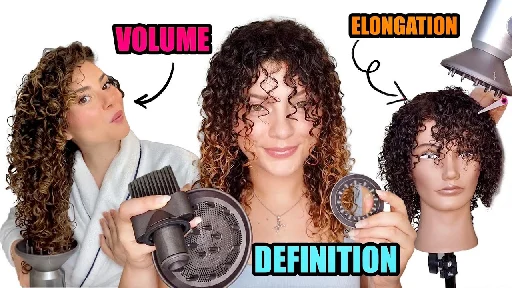
YouTube Video
Click to view this content.
Definition: hover diffuse. Volume: scrunch diffuse. Elongation: diffuse with comb
It sounds like you have contact dermatitis, you are allergic to the shampoo you were using. I'm not a doctor, but I am glad you are going to go see a doctor. In the meantime maybe some antihistamines and/or hydrocortisone over the counter at your local store can help.
Here's a health line article about scalp dermatitis.
There's also this blog here that talks about scalp conditions.
I'm pretty sure once the allergen has been eliminated that your hair and scalp will recover. It's probably not worth buying new products yet until the doctor can look at you but if you need products that are more friendly (fragrance free) to eczema and such in the future, there is vanicream/free and clear. Sorry this is happening to you. I had dandruff before and I thought that was really bad, a medicated shampoo prescribed by my doctor was able to clear it so I am hoping your doctor can do the same for you.
That's too pricy for me but good to know about.
Yeah if I didn't have curly hair, my hair would look flat and lifeless so always happy it's at least curly!
Saaame. I use a diffuser to try to help with volume and it doesn't take a long time to dry but I still would love a thicker mane.
I used to have higher density hair but now I'm struggling with it thinning. It was always fine tho. I would ask a doctor because it turned out I was anemic so I started adding more iron to my diet. I also added more protein shakes since I was also lacking in that department (I rarely eat meat, I've been trying to become vegetarian).
You can have some hair loss or even changes after having kids, mine was telegon effluvium from stress and possibly medication. I've heard of women going from straight to curly with the hormonal shift. Same with after chemotherapy. I'm not a doctor tho, they could give you better information.
I've thought about minoxidil but I wanted to talk to my doctor again about it before going that route. I dread the minoxidil dread shed. I've been using the ordinary hair density serum to help with the shedding, it kinda helps but could be better. I also microneedle my scalp once a week with a derma stamp at 1.5mm. On wash day I mix some rosemary oil with squalane oil and leave that on my scalp for a few hours before washing it off. As for multivitamins, I do take them but I'm not sure if they help. They only help if you are missing those vitamins in your body. I take a hair, nails, and skin vitamin, omega 3 6 9 vitamin, and vitamin d3.

As someone with fine thin hair, I feel this in my bones
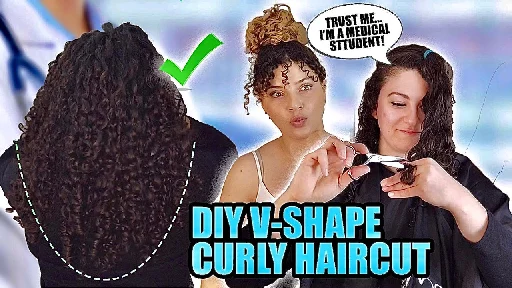
YouTube Video
Click to view this content.
My hairstylist left the state, I have severe trust issues so I've been trying to cut my hair myself. I have a V shape and long layers so I tried this haircut to just trim the ends. It came out alright, not as good as my hairstylist would have done but acceptable. I still recommend you go to a hairstylist but for anyone like me, this might help. I trimmed very little this first time, I'm planning to trim just a little bit over the next few washes as I get used to it, no more than maybe 2 inches total.
Mine says connection reset by peer.
I use coconut oil with success but it is true that some people's hair reacts badly to it. I just quoted the video but maybe should have added a warning to the advice. It felt weird for me to correct a doctor lol
Coconut oil's "miracle ingredient" is medium-chain triglycerides, a variety of fat or oil. Human sebum (skin oils) only contains around 35% triglycerides in general, and far less (maybe 10-15%) are shorter to medium-chain triglycerides.
In addition to the somewhat unique medium-chain triglyceride content, coconut oil is also high in saturated fats (those which solid at cooler room temperatures). Saturated fats tend to penetrate hair well also. This is another characteristic of coconut oil which may create a problem for hair. The oils produced on our skin contain some triglycerides and saturated fatty acids. But not as much as coconut oil contains.
Coconut oil is so good at penetrating the hair because the medium-chain triglycerides are both small enough to seep between cuticles and they have polarity (a charge) that attracts them to the protein in your hair. Coconut oil is actively drawn to the inner portion of your hair whereas other oils need to seep through slowly. This is unlike most other plant oils. The saturated fats with short carbon chains can slowly soak in to hair as well. No wonder coconut oil can behave so strangely!
https://science-yhairblog.blogspot.com/2014/06/coconut-oil-makes-my-hair-stiff.html

YouTube Video
Click to view this content.
- Shampooing every day is bad for your hair
Not all hair types can handle shampooing every day but it isn't bad for everyone. Shampooing is meant to cleanse the scalp. It prevent yeast from causing inflammation, dandruff, and hair loss. This buildup needs to be removed.
- Shampoos will make my hair grow
No such thing as a shampoo that will make your hair grow. Make sure that you get rid of the oily buildup with shampoo but there are no ingredients that can grow your hair. Medicated shampoos don't grow hair or affect the hair cycle, they help reduce inflammation. Shampoos with protein marketed for thin hair can make hair appear thicker but it is not getting thicker.
- Dry hair needs moisture
Moisture (water) makes hair frizzy and brittle and prone to breakage. Humidity can cause breakage because of all the moisture (water) content in the air. You want instead products that help coat the hair and keep it smooth and prevent it from absorbing so much moisture. You need conditioning products for hair. Wet hair is very delicate. Coconut oil can help reduce hygral fatigue when you apply before your shower.
- You need to trim the hair every 6 weeks for it to grow and avoid split ends
It's not right for everyone. Trimming ends does not affect how much hair comes out of your follicle. If you have split ends, you will need trims to avoid breakage. Trims don't prevent split ends, trims gets rid of them. Use deep conditioning products and avoid too much heat to prevent split ends.
- Your hair gets used to your shampoo and conditioner
Products have ingredients that make them unique for a specific outcome. Your hair does not get used to it. Your hair might need a change if the product isn't giving you results because of the change in environment, etc. But it is not because your hair gets used to it.
I'll celebrate when we have universal healthcare, until then it's just bs to me.
What happened to vlemmy.net? I'm OOTL, all I know is I can't login or reach the server.

YouTube Video
Click to view this content.
Heat can crack and fray hair by destroying the proteins in hair. The vibrancy will fade, tone will change, there will be a loss of pigment, it will lose shine, and hair will become dull. Heat damage will also cause split ends and breakage.
Straightening and curling irons can go 360-450°F or 185-230°C. Water boils at 212°F or 100°C. Hair can hold 30% of its weight in water. When there is excessive heat (like above water's boiling point) applied to hair that is still wet, the water will burst out into steam and greatly damage the cuticle.
Benefits of using heat: easier manipulation, can set styles with better results, and efficiency.
How to use heat safely:
-
use a diffuser for indirect heat
-
lower the heat setting
-
use a hair dryer with excellent temperature control that does not go above 212°F or 100°C
-
squeeze out all water by towel drying before using heat
-
use the hover diffuse method
-
use a heat protectant (like products with PVP/DMAPA acrylates copolymer, quaternium 70, hydrolyzed wheat protein, and especially silicones)
Unless you are using temperatures above water's boiling point (212°F or 100°C), heat damage is less of an issue
Before using irons feel if hair is still wet. If hair is cold when you touch it, it is still wet. Use irons on dry hair only.
If you have fine hair, use lower heat, heat protectant, and products with protein in them to strengthen hair
Shameless plug for !curlyhair@lemmy.world it's a community about all things curly hair related.
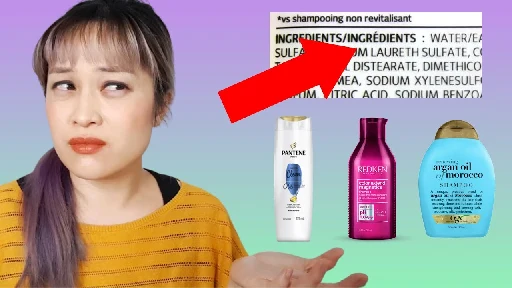
YouTube Video
Click to view this content.
What everyone gets wrong with shampoo
Lots of people say you have to use sulfate-free shampoo to avoid damaging or stripping your hair. There also people who say you have to use shampoo with sulfates to get your hair clean.
They are both wrong.
Academic hair science is a mess. Hair is very diverse. Different hair reacts differently to ingredients. Ingredients work similarly on skin but with hair, ingredients work differently.
If 100 people use glycerin on their skin, you might have 60 people’s skin get more hydrated and improve, 20 people’s skin stays around the same, the final 20 might get worse for some reason – like the glycerin helped some other ingredient penetrate and their skin got irritated, or they have an allergy. There’s still complexity, but you wouldn’t have half the people’s skin dry out more. But that’s kind of how it is with hair.
Variation in curl pattern can also affect how ingredients work.
When it comes to wet vs dry detangling, water makes hair weaker inside and cuticles raise so you should detangle when dry. At least on straight hair. But on curly hair, hair sticks less to each other (like spiral pasta vs spaghetti pasta) and the weakening bonds makes it less damaging and results in less breakage. But even then, we still don't know everything (which is better for wavy hair, what if you use a brush or comb, what if you bleach your hair, what if your hair is longer, etc.). There's a lot of variables.
Hair science is really sparse. You can't generalize hair. Even things like humidity can change the results. The structure of hair as we know it is still evolving and there isn't a lot of consistency in terminology.
For example, around the late 90s, some hair scientists decided that half the protein in hair wouldn’t be called keratin anymore. But not everyone follows this. You’ll see things like “hair is 80% keratin by mass” in a paper from 2017. It’s clear they’re using the old definition – but if a paper says “we concluded that this ingredient works on keratin in hair”, what do they mean by “keratin?"
Hair products aren't about individual ingredients, it is about the overall formulation. Sulfates usually refers to sodium lauryl sulfate and sodium laureth sulfate, which are surfactants. Surfactants help break up oil and mingle with water so you can rinse it. Sulfates have sulfate heads, the tails are similar to other surfactants.
These 4 diagrams show 4 different ways that shampoos clean at a microscopic level – each diagram goes from left to right. The pink tadpoles are the surfactants.
You can see that the surfactants are working together to clean the hair. This is called a supramolecular process, where molecules are interacting without going through a chemical reaction.
And all 4 of these are probably happening on your hair at the same time, to different extents – there’s probably more mechanisms still to be discovered.
How much of each one is happening depends on the formula of the shampoo and what type of stuff you are cleaning off.
If you look at the ingredients, you'll have 3 or more surfactants. If you change the ratio of the ingredients or swap one of these surfactants with something else, the shampoo will work differently. Plus there's other ingredients like polymers to take into account. The texture of the shampoo and opening of the bottle changes how it disperses and spreads as well.
Even just checking the pH of a product isn't the whole picture when it is so complex.
Cosmetic formulators spend a lot of time just doing trial and error, making formulas and trying them out. Changing little things about the formula causes big changes.
Good Housekeeping did a test with 10 shampoo and conditioner pairings. Some had sulfates and some didn’t. The set that stripped hair dye the least had sulfates – it was Tresemme’s Keratin Smooth Color set.
Formulators know that people who go for sulfate free want a gentler shampoo so that's what they aim for when making the formulation. They know there’s all these widespread myths about sulfates being harsh – they’ve been around since the 90s. Adding sulfates doesn't mean it will strip more. There’s a good chance that if you grab a random shampoo with sulfates, and a random shampoo without sulfates, the one with sulfates will clean better because of product design and that's how they were formulated. It’s not because just adding sulfates automatically makes shampoos strip more. They might have also added other ingredients to make the hair feel cleaner.
How well it foams doesn't tell you how well it cleans. How well something foams depends on how a formula interacts with air and water to stabilise a thin stretched out film of water. Cleaning is about how it interacts with oil and dirt. But if something doesn’t foam when we use it, we tend to feel it isn’t cleaning well. It’s just a psychological thing.
How well a shampoo cleans is complicated. Bottom line: Sulfate-free and sulfate-containing don’t really mean much. How well a shampoo cleans is too complicated to predict that easily.
It’s much more useful to look at what the shampoo is telling you. If it says “clarifying” it’s a shampoo designed to clean your hair better, if it says “colour protection”, it can have sulfates and still strip dye less. It’s also really useful to look at reviews from people with similar hair to you and try a sample before buying.
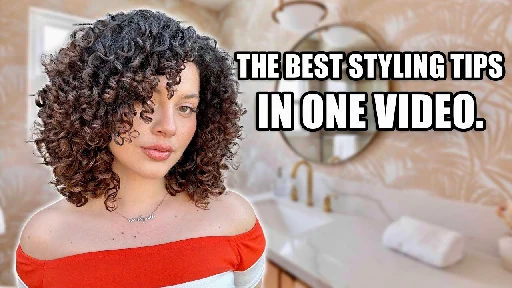
YouTube Video
Click to view this content.
Prep, Style, Finish
- Prep: Leave-in conditioner, leave-in treatment, serums, primers
- Style: products (mousse, foams, creams, custards, gels, pomades, hairsprays), techniques
- Finish: hair oil, serum, hairspray, texture spray
Rule of thumb: the amount of product you apply is how much hair is on your hair (density), cup your hair (ok symbol) and that is how much you should apply but if you have shorter/longer hair you will need to adjust
If a product is thicker, start less and work up.
Damp styling: quicker dry time, more volume, less clumping
Brush product through to evenly distribute it throughout hair
When you wring your hair, you can see how much is in there. Don't drown it in product (becomes white). Apply evenly root to tip.
Keep spray bottle with water in hand
Section hair for the amount of volume you want. Mell sections hair in two, a bottom and top section.
Style 90 degrees off scalp (half base) and in vertical sections.
If hair is healthy with good elasticity then brushes are a good way to define curls
Ribbon technique: using tension while brushing by sandwiching hair between brush and hands. Should not hurt or pull. It will look straight but curls will bounce back, you can scrunch to encourage bounce back.
Gels give longevity but sometimes brushing it through makes it stringy and crispy. So apply it after brush styling, smoothing down /glazing (praying hands)
Make sure hair is evenly wet from root to tip. Rewet top section after doing bottom section.
If you like side parting, style top with v back method (dividing sections into V shapes). If section is very large, brick laying can be done (doing a V section and then a straight/horizontal section, and then V again, etc.) Smaller sections if hair is more coily, larger sections if hair is more wavy. And then finger coil or brush back bangs
If your towel is more damp then dry, it will absorb more water like a sponge. Squish out extra water with towel, be gentle.
Diffusing: When you scrunch diffuse you are disturbing the curl pattern, curls have not set yet, encouraging a lot of shrinkage (maybe too much), and drying out the ends faster than the roots so roots will be frizzy and wet. Instead hover diffuse. Once there is a cast, then you can scrunch with the blow dryer.
If hair is cold it is still damp. Once hair is fully dry, then add the finishing products like hair oil, serum, hairspray or texture spray. Then you can smooth out the gel cast and separate any clumps to add volume
I have fine hair and am looking into trying more products. I'm a bit of a product junkie, always looking for a product that performs better than my current ones.
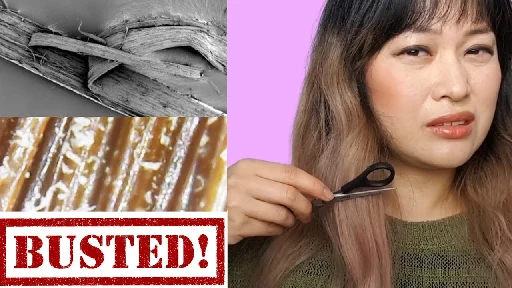
YouTube Video
Click to view this content.
- Scrape test will show you all the buildup on your hair
Premise: scraping hair with scissors will show if there is "buildup" on the hair from silicone.
Experiment: wash two samples of hair twice each with a clarifying shampoo and use a conditioner with silicone on one sample and nothing to the other. Both strands were then scraped with scissors.
Result: lots of white residue came off the silicone treated hair and the sample with no conditioner.
The white residue is actually your cuticles being shredded and this act is super damaging to your strands.
- Drug store products buildup on hair, premium products don't
All conditioning products leave something behind to plug up the gaps and weaker spots in hair. Hair gets damaged everyday by brushing, washing, sun exposure, hair drying, straightening, and possibly bleach if you use it. So the hair strands initially grow out resistant with flat cuticles (not damaged) then become strands with raised cuticles with holes and gaps in them (damaged). To make the rough hair that has been damaged feel smooth again, conditioners plug up the gaps and some penetrate further inside the hair to make it smoother and stronger.
When hair is wet it gets negatively charged, the positive charge from cationic conditioners stick to the hair and reduces static and makes it smoother. Other conditioning ingredients include polyquaternium polymers, hydrolysed proteins, oils, and silicones. They work the same whether they're in luxury products or drugstore products.
- Product is bad if it weighs down hair
There are three main factors that determines how much conditioning ingredients will stick to your hair: what the ingredient is, how it's used on your hair (how you use it, how much is in the product, the formula), and what your hair is like. Don't use corase resistant products on fine porous hair, that will cause it to be greasy and stick together. It's like how a product for dry skin might be awful on oily skin.
- All silicones are the same
If you have enough silicone with a positive charge on your hair, extra silicones won't stick on anymore. Silicones can be heavier or lighter depending on its structure but still have the same name - e.g. dimethicone is a polymer that can be lots of different lengths and have different properties. Longer chains are heavier and thicker, shorter chains are more lightweight and spread more easily. There are lots of different grades, these grades do not mean higher and lower qualities.There's thousands of silicones. Just because you have a bad experience with one silicone doesn't mean that all silicones will react that way.
- What are your thoughts on these myths?
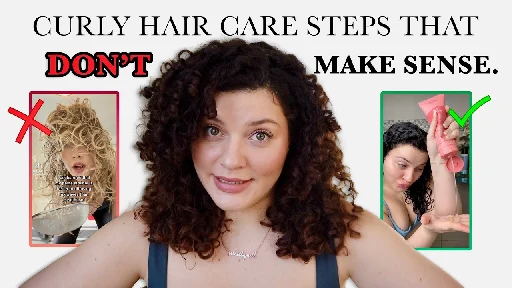
YouTube Video
Click to view this content.
>Don't use deep conditioner before shampoo. Use something cheap if you do because it is a waste. You should instead do an oil treatment.
>Don't cowash if you are not washing more than 2 times a week
>Smooth down conditioner rather than scrunching it in
>Add water when detangling to help with slip
>Deep condition when needed (mostly it is meant for not healthy hair)
>Curl training while doing a treatment does not work, waste of time
>Don't leave deep conditioner in for more than 30 minutes, waste of time
>Use products for your texture and porosity
>Prep with primer or leave in conditioner and then style with gel or foam, etc.
>Save scrunching for the end
>Add water (with spray bottle) before adding each product
> Dry hair with (micro fiber) towel gently before air drying or diffusing, especially in high humidity

>How porous or absorbent your hair is has a lot to do with how it looks and can help you decide what to use on your hair to help it look it’s best. A porosity is a hole or a gap – an opening.
>Hair which is porous [aka high porosity] will take on water and other chemicals easily because of all the tiny openings in the cuticle. Water gets in and out easily.
>Hair which is not very porous [aka low porosity] repels water and most other fluids and this is a good thing. Water doesn't get in or out easily.
>It's fairly common to have hair that is porous on the ends, but not at the roots.
>What causes porosity?
>Weathering of hair, mechanical stress [combing, especially brushing, tieing up, rubbing, etc.], wetting and drying, shampooing, chemical treatments, and physical structure of hair. If your hair has waves, curls or (especially) kinks (and wavy hair can be kinky hair too), it is likely to have areas on the strand which are narrow, flattened, twisted or otherwise not as strong. Even the “cuticle armor” cannot protect these areas adequately. These are prone to breakage and damage and therefore become porous easily. Wavy and curly hair is also more prone to damage from daily life simply because it has bends in it.
>How to Determine Your Hair's Porosity:
>This is something you learn from studying your hair by running your fingers over a hair strand, observing shine or reflectivity, how hydrated your hair feels on a daily basis, and your hair's response to products.
>Normal-porous hair: It shines, maybe not quite as much as not-porous hair. It perms and takes color as expected. Your hair can be normal-porous even if you use some heat on your hair (low-heat diffusers). Normal-porous hair does not become oily-looking with reasonable amounts of conditioners or oils. Normal-porous hair may have times when it feels a bit dry, or not dry at all and it is easy to make it feel "not dry" and soft with hair conditioner and gentle care. You perceive some "soaking in" of hair products. You probably have had some exposure to the full sun, possibly chlorinated swimming pools. Your hair may be not-porous near the roots and normal-porous further down and therefore respond differently to conditioners in those two areas, which is why many people condition their hair from the ears, down. If you run your fingers up and down an individual hair, it feels mostly smooth. This normal-porous hair has cuticle scales which look like shingles on a roof. They overlap and don't stick up much.
>Porous hair: If you run your fingers up and down a hair strand, it may feel bumpy and uneven due to kinking, or to damage. Quite porous hair does not shine much and though it may have some gloss, it's not "reflective" or brightly shiny. It will seem to absorb hair products of any kind, tends to feel dry most of the time and you have a difficult time getting it to feel soft and pliable. Porous hair usually takes on dye, permanent waves and chemical straightening quickly. And loses dye quickly. Porous hair loses moisture easily.
>Maintain Porosity:
>Avoid too much handling, tight ponytail holders, excess heat (curling or straightening irons, blowdryers without a diffuser), prolonged exposure to sunlight, chemical treatments (permanent waves or chemical relaxers), and bleaching or permanent haircoloring. Don’t rub your hair roughly with towels, tie it up tightly every day, use metal barrettes with sharp edges. Avoid brushing or combing vigorously and with force. Do detangle with care, don’t wash hair every day, use dilute shampoos or mild shampoos.
Taken from:
https://science-yhairblog.blogspot.com/2011/09/porosity-in-hair.html
https://science-yhairblog.blogspot.com/2012/06/hair-porosity-how-to-measure-sort-of.html
Ultimate CG Guide by r/curlyhair mod team. Note: you do not have to follow the curly girl method listed here, it's ok to use shampoo, sulfates, and silicones if they are working for you / Mirror
But if you do want to follow CGM here is an ingredient checker
r/curlyhair Holy Grail List / Mirror
International product list / Mirror
Types of frizz and How to Tame Them
Protein and Moisture do not balance
Humidity and Humectants Part I

I recommend using a chelating shampoo instead of the listed alternatives, it is easy to mess up hair if you don't have the proper pH. A chelating shampoo will be the proper pH and is effective.
Taken from:
https://www.instagram.com/p/CkZHgkDIM-6
The showerstik is the only shower head that can actually filter out the minerals that I know of, regular shower heads can help remove chlorine but will not make water soft.
Hardness prevents soap from lathering by causing the development of an insoluble curdy precipitate in the water; hardness typically causes the buildup of hardness scale (such as seen in cooking pans). Dissolved calcium and magnesium salts are primarily responsible for most scaling in pipes and water heaters and cause numerous problems in laundry, kitchen, and bath.
Symptoms of Hard Water include:
-
Stiff, dingy laundry
-
Mineral deposits on dishes and glassware
-
High soap usage & need for fabric softeners
-
Extra work to remove soap curd on bathtubs & shower stalls
-
High energy costs, possibly due to scale build-up in pipes and on appliances
-
Scale build up in sinks, tubs, faucets & appliances
Taken from:
https://wqa.org/Learn-About-Water/Perceptible-Issues/Scale-Deposits/
Map of Hard Water in the USA (USGS):
General guidelines for classification of waters are:
-
0 to 60 mg/L (milligrams per liter) as calcium carbonate is classified as soft
-
61 to 120 mg/L as moderately hard
-
121 to 180 mg/L as hard
-
More than 180 mg/L as very hard.
Taken from:
https://www.usgs.gov/special-topics/water-science-school/science/hardness-water#overview
Memes about curly hair
Pictures of curly hair
Hair science (ingredients, properties of hair, etc.)
Discussions / Questions
Curly hair care tips
Links to video routines
Tutorial links
Product reviews
I wish I would have known that you should squeeze out all water from your hair before drying, that leave-in conditioner is much better than heavy creams for me, that I need a buttload of conditioner to detangle properly, that gel is pretty awesome when you scrunch it out, co-washing is not that great for me / I need low-poos + clarifying shampoos regularly, protein is my best friend, and that blow dryers + diffuser can be used without getting heat damaged with proper use. I also wish I never had my hair relaxed and I wish I didn't try ironing it so much. My hair looks super dead in some of my school pictures before I chopped it off. I also once ruined my hair when I used an iron on WET hair. Omg the damage 💔







